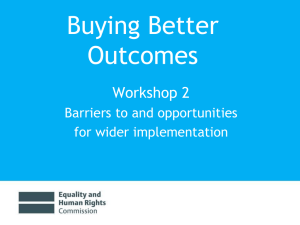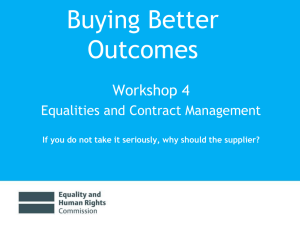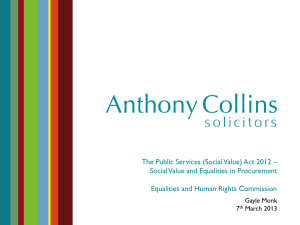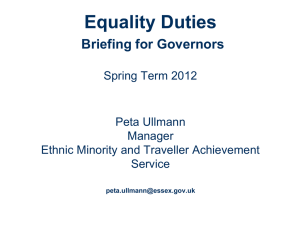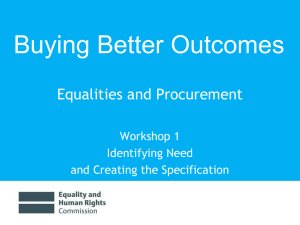Powerpoint - Equality and Human Rights Commission
advertisement
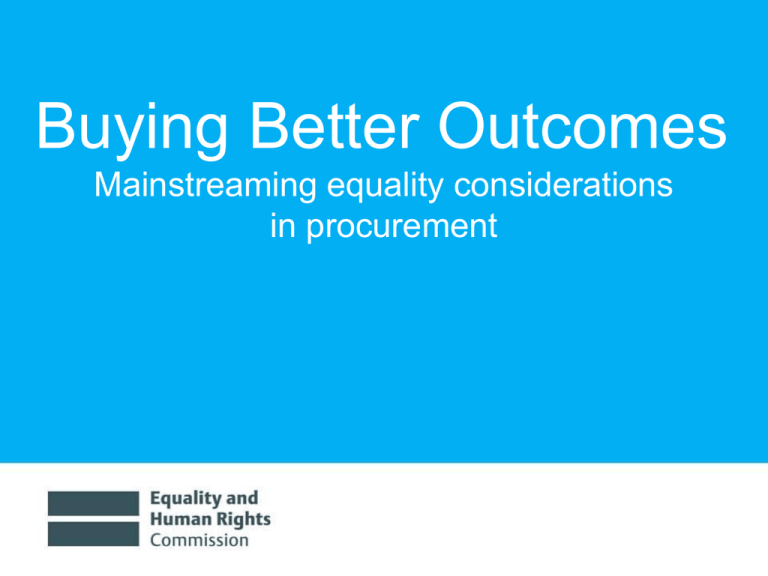
Buying Better Outcomes Mainstreaming equality considerations in procurement Part One The Equality Act 2010 The Equality Act 2010 • Streamlines and simplifies • distils nine Acts into one • harmonises definitions and exceptions • Strengthens • generic Equality Duty on public bodies • bans age discrimination • extends positive action • harmonises upwards protection across strands Public Sector Equality Duty (the general duty) Public authorities, in the exercise of their duties, must have due regard to the need to: • eliminate discrimination, harassment, victimisation • advance equality of opportunity • Act refers to removing or minimising disadvantage, meeting needs of people with protected characteristics or encouraging participation where participation is disproportionately low • foster good relations • Act refers to tackling prejudice and promoting understanding The Specific Duties Public authorities subject to the specific duties must publish: • one or more specific and measurable equality objectives, at least every four years • information to demonstrate compliance with the general equality duty, at least annually • must include, in particular, information relating to your employees (for authorities with 150 or more staff) and others affected by your policies and practices such as service users • the information must be accessible to the public The PSED and procurement The general duty applies to commissioning and procurement: • It applies to all contracts, regardless of value • Public authorities cannot delegate their obligations under the duty to the contractor • It has implications for the procurement process: • You must have had due regard to the 3 aims of the general duty when procuring and be able to demonstrate compliance • This means ensuring that contractors are required to provide any relevant information you will need to be able to demonstrate compliance, in case of challenge Part Two Buying Better Outcomes Role Of Procurement in Equalities Compliance vs. Good Practice The duty require only ‘due regard’ • extent of relevance determines how much you must do • good practice has the potential to go beyond compliance with the duty to provide better outcomes and greater gains for your community and your organisation • particularly if you take a more comprehensive and strategic approach What a good corporate approach to equalities and procurement involves • It is genuinely corporate and strategic - relates to and refers to your corporate objectives, looks across the authority for wider (community) benefits, has visible commitment • It brings together equalities, procurement and service managers - joint work or at least joint thinking • It mainstreams equalities considerations into procurement process • It is consistently implemented/used across the organisation • It addresses all the stages of the procurement process • It addresses the Public Services (Social Value) Act 2012 Corporate Need and Strategic Fit Government Policy Authority Corporate Plan and Strategy Department Service Plans Procurement Strategy Financial Regulations Authority Contract Procedure Rules Public contract regulations The Procurement Value Proposition Efficiency DEMAND/ MARKET MANAGEMENT COMMUNITY OBJECTIVES & VFM Effectiveness BENEFITS REALISATION Economy COST CONTROL & REDUCTION Community gain • The procurement should be advancing and contributing to your organisation’s objectives - in this case those relating to equality • Effective demand management should direct use to the right customer segments • Benefits realisation should ensure equalities benefits are not only identified but achieved • Cost control and reduction can be achieved by demonstrating that effective equalities management can result in overall budgetary savings and increased value for money The Procurement Cycle and Equality 8. Closure / Review 7. Manage Implementation of Contract 6. Award Contract 5. Tender Evaluation 1. Identify Need 2. Develop Business Case 3. Define Procurement Approach 4.Market Supplier Appraisal Identifying need • It is at this early stage that equality issues must be first considered • Are the whole range of protected characteristics being considered? • Use your knowledge of your communities and clients to identify diverse needs. • Considering the likely impact on equality of the goods/services is a useful way to start developing the specification Assessing impact on equality and procurement This provides a systematic way of assessing how decisions about policies, services or functions . • It helps you decide what to buy • It enables you to consider right from the start the equalities impact of what you decide to buy – and how you buy it • and indirectly who is likely to be able to bid It helps you assess relevance and proportionality and provides evidence of having due regard and therefore legal challenge Specification • Has the likely impact on equality of the goods/services been considered? • Relevant core equality requirements should be highlighted here • How will the equalities-related requirements be evaluated and measured? • Does the specification allow for continuous improvement and change – e.g. the changing demographics of your communities? The Procurement Business Case Are relevant equality requirements being considered thoroughly at the procurement business case stage? Are all of the criteria normally considered at this stage being addressed: • Strategic fit - does the inclusion of equality and diversity measures add value to and meet your organisation’s vision and objectives? If so it is adding benefit? • Cost/benefits - what are the costs involved and do they justify the expected benefits. How can these extra benefits be realised? The Procurement Business Case cont. • Affordability - can you afford to undertake this or will extra resources need to be identified elsewhere? • Achievability - is what you are requesting reasonably achievable or are you creating unnecessary red tape and bureaucracy? Will it prevent smaller suppliers bidding? • Options - what options are available to the organisation and what impact may they have in terms of addressing Equality and Diversity issues? • Risk - what are the risks involved and who should be responsible for them? Going to Market • At this stage your organisation will be evaluating your supplier and market options • Is supplier diversity considered? • could you develop diverse and competitive sources of supply from small firms, ethnic minority businesses, social enterprises and voluntary and community organisations? • Have the implications of how you bundle contract requirements and the way you advertise opportunities (to attract a wider range of suppliers) been considered? • If you use PQQs, is a simple one being used for lower value contracts? Have information requirements been tailored to the size of supplier? Going to Market • Is your organisation thinking how to encourage larger suppliers to work with smaller sub-contractors who may be better equipped to provide a service or product for your staff or residents? • Is it quite clear what you are trying to achieve in your invitation to tender with regard to equalities? • and what they will be required to do and monitor? • sufficient information should be provided to help suppliers arrive at a suitable submission to meet your requirements • The criteria used for your evaluation can include equality criteria but must relate to the subject matter of the contract • Have equalities contract terms/ clauses been included? Performance and Contract Management Has monitoring of equalities requirements and clauses been included in a rigorous performance monitoring and management arrangement and this agreed with the supplier? • clauses such as those for equality and diversity requirements can easily be overlooked in the rough and tumble of contract delivery • is it clear how shortfalls in expectation will be dealt with? • how will poor performance be communicated? • if you do not take equalities seriously, why should the supplier? Performance and Contract Management (cont.) Have roles and responsibilities for managing the relationship with respect to equalities been defined? • appropriate training for those who manage the contract or are involved on a day to day basis with the suppliers’ staff may be helpful Performance and Contract Management (cont.) Are equalities issues (that relate to the contract) are systematically and regularly addressed at meetings with the supplier? • should equalities staff be regularly involved or consulted on the contractor’s performance? • what do users, front line staff, the unions and others report? Is the issue of how to continuously improve the supplier’s equalities performance throughout the course of the contract and/or (voluntarily) improvement, across their whole organisation being discussed? Realising the Benefits • One of the most difficult aspects is actually realizing the potential benefits that you have identified. • As part of your performance management process • are these benefits being identified as targets? • Are they clearly recorded to demonstrate that benefits have been realized and contributed to policy outcomes and the community? Realising the Benefits (cont.) • Have benefits gained by the supplier, in terms of reputational value, of access to a larger workforce pool and ultimately a wider customer base, been captured and recognised? • It is sometimes forgotten in the quest for VfM that not all added value has a £ sign in front of it. Try to find ways of recording other benefits such as improved social relations and reduced social stigma. A number of tools to measure value have now been developed e.g. the SROI model…….Try to keep it simple. End contract / termination Are proper arrangements in place to deal with end of contract requirements with regard to equalities, particularly with regard to staffing matters? Make sure that any lessons to be learned are identified and applied to future contracts and equality objectives: • could future specifications be improved? • was there enough scope for real benefits to be achieved? • would different contract terms and conditions have been more effective? • could performance management have been more effective? Were you able to play your role fully in delivering this aspect of the contract? If not, what changes are needed in the process? Barriers to effective implementation Myths: • EU regulations do not allow it • equalities are often not relevant • building equalities into procurement is not compatible with VFM and • doing so places burdens on suppliers and public bodies Organisational/cultural factors: • who is responsible for compliance? - need for clear corporate approach and consistent processes • silos – between departments and partners - differing views These can all be overcome
